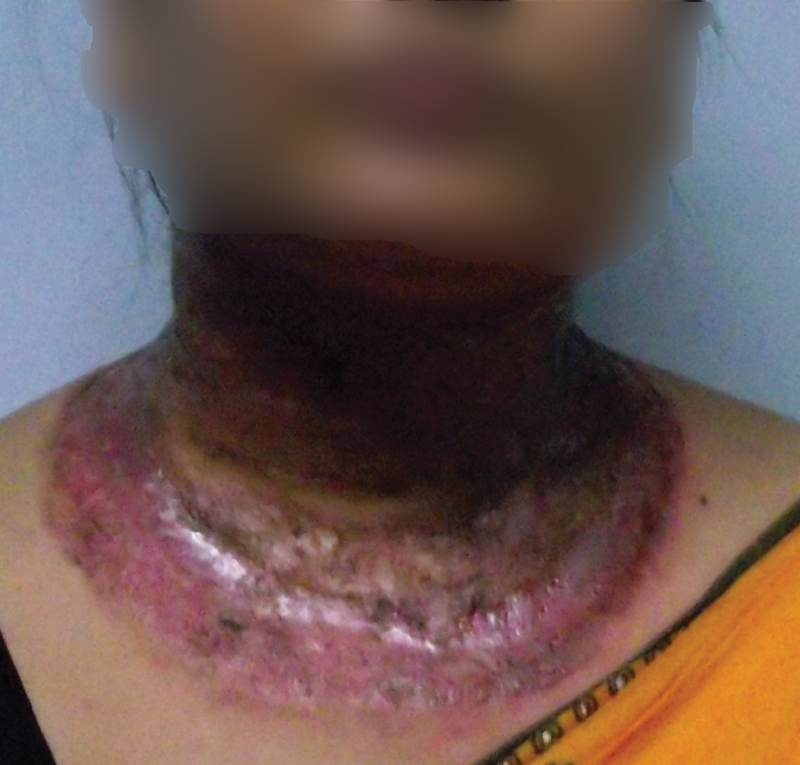Translate this page into:
Allergic Contact Dermatitis Due to Cervical Collar
Prasad Krishnan, MS, MCh Department of Neurosurgery, National Neurosciences Centre, 2nd Floor, Peerless Hospital Campus 360, Panchasayar, Garia 700094, Kolkata, West Bengal India prasad.krishnan@rediffmail.com
This article was originally published by Thieme Medical and Scientific Publishers Pvt. Ltd. and was migrated to Scientific Scholar after the change of Publisher.
Abstract
Abstract
Cervical collars are routinely applied in neurosurgical units following trauma or cervical spine operations. We describe a case of florid allergic contact dermatitis that developed as a complication following collar application in a postoperative patient.
Keywords
allergic contact dermatitis
Casal's collar
cervical collar
complications
A 30-year-old lady underwent an anterior cervical discectomy for a C5–C6 disc prolapse causing radiculopathy. Postoperatively, she was put on a Philadelphia collar and discharged 3 days following surgery. She presented 2 weeks later with an intensely pruritic, erythematous, sharply demarcated rash on the neck, lower part of the face, and upper part of the chest (Fig. 1). The rash resembled dermatitis seen in niacin (Vitamin B3) deficiency–Casal's collar. As she had no other features of pellagra and considering the localized nature and time frame in which the rash developed, allergic contact dermatitis was diagnosed. She was treated with removal of the collar and application of topical steroid ointments with which the lesion regressed completely in 3 weeks.

-
Fig. 1 Clinical image of a patient with sharply demarcated, erythematous rash on the neck following application of a cervical collar for 2 weeks.
Fig. 1 Clinical image of a patient with sharply demarcated, erythematous rash on the neck following application of a cervical collar for 2 weeks.
Allergic contact dermatitis is a type 4 delayed hypersensitivity response mediated by T lymphocytes when a patient's skin comes in contact with an allergen.1 It is the commonest inflammatory disease of the skin and as in our case occurs more in women than in men.1 Despite the fact that common complications seen due to cervical collar applications such as erythema, skin breakdown, and pressure ulcers have been reported to occur in 7 to 23% of adults,2 these are neither something that the patients are counseled about nor an issue that surgeons usually bear in mind while treating patients. Webber-Jones et al3 have cautioned that areas of skin damage carry a risk of bloodstream infections. While some of these complications can be prevented by the addition of extra padding4 at pressure points, allergic contact dermatitis as seen in our case has never before been reported in the literature and mandates doing away with the offending collar altogether.
Conflict of Interest
None declared.
References
- Allergic contact dermatitis.StatPearls [Internet] In: [Updated 2021 Jul 26]. Treasure Island (FL): StatPearls Publishing; 2021. In: . Available from:
- [Publisher] [Google Scholar]
- Cervical spine injuries and collar complications in severely injured paediatric trauma patients. Spinal Cord. 2013;51(5):360-364.
- [Google Scholar]
- The management and prevention of rigid cervical collar complications. Orthop Nurs. 2002;21(4):19-25. , quiz 25–27
- [Google Scholar]
- Complication of hard cervical collars in multi-trauma patients. Aust N Z J Surg. 1994;64(2):139-140.
- [Google Scholar]







